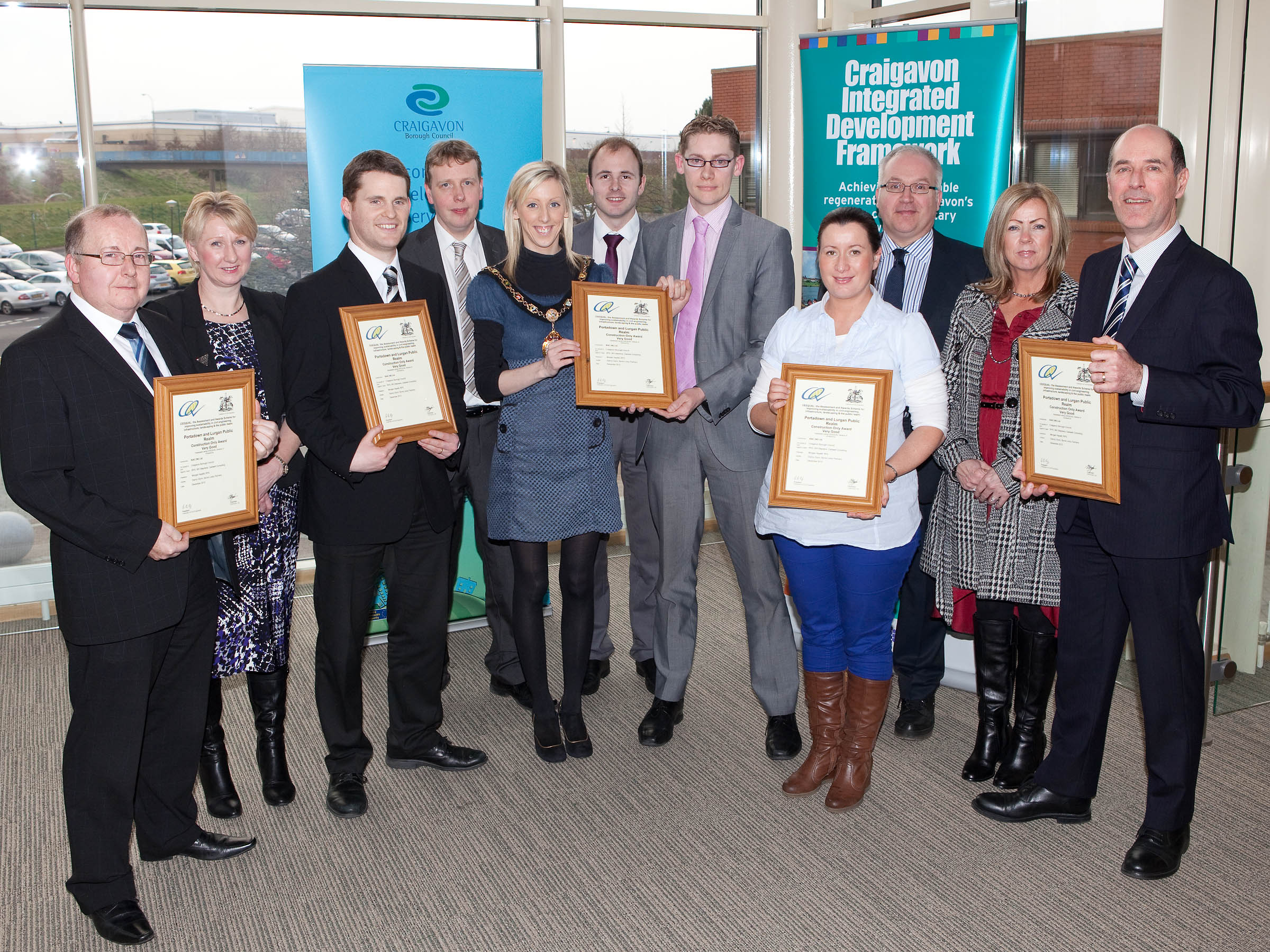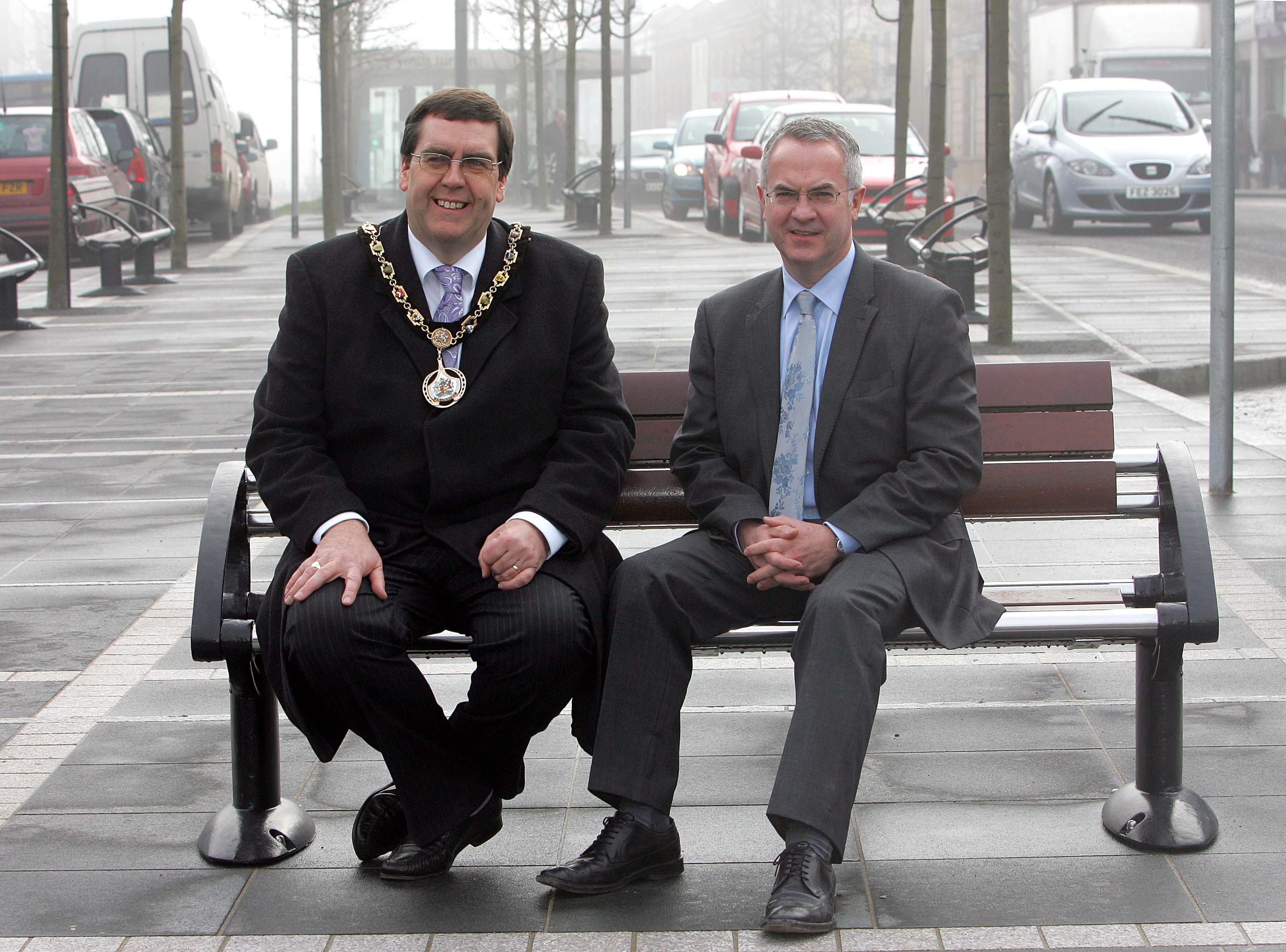Portadown and Lurgan Public RealmConstruction Only Award Project Team |
|
The Project
Within Craigavon Borough there are three town centres: Central Craigavon, Lurgan and Portadown. While Central Craigavon emerged from the ‘new towns’ movement and has a quite unique form and function, Lurgan and Portadown are fine examples of traditional market towns. Lurgan Town Centre is a Conservation Area and an Area of Townscape Character. Portadown has developed as a market town and in the past was a significant centre of commerce with seven linen mills, a foundry and pottery works. Much of the centre of Portadown remains unchanged from its origins as a market town.

Figure 1: Project team with key stakeholders after the CEEQUAL Award presentation
Craigavon Borough Council recognised the importance of a high quality public realm including more space and ease of movement for pedestrians in both town centres to promote them as preferred shopping precincts. The creation of new shared space for events and activities, whilst recognising the need for vehicular movement and parking was also seen as a key challenge. The salient features of the scheme are:
Live Public Realm / Streetscape upgrade:
- 10,600 m2 of granite paving in Portadown
- 6,700 m2 of granite paving in Lurgan
- 5,000 m2 of asphalt footpaths in Portadown
- Portadown – 57nr Quercus Palutris (Oak) semi-mature trees
- Lurgan – 47nr Tilia Cordata (Lime) semi mature trees
- Street furniture, street lighting and other miscellaneous works in both towns
The project was funded in partnership by the Council, the Department for Social Development, and Roads Service (an agency of the Department of Regional Development).
A design and build approach was adopted, using the NEC ECC Option A form of contract. The client’s design team included: RPS Group as project managers, CEEQUAL Assessors and landscape architects; WH Stephens as cost managers; and Caldwell Consulting as M&E engineers. SIAC (NI) Ltd led the construction team, and were supported by URS as civil engineers and Delap & Waller for street lighting design.
The outturn cost of the works was £6,842,339. The works were completed over 18 months ago after commencing in August 2009, and with a two season defects period to cover feature tree planting, the final handover occurred in February 2013.
Northern Ireland public procurement policy promotes sustainable construction principles. The Craigavon Borough Council Development Team works with local communities to ensure that everyone has access to a good quality of life. This includes developing appropriate partnerships with community and other organisations that will demonstrate or assist in delivering practical examples of sustainable development. The Council also has a range of economic and physical development functions which require effective partnership working between businesses, communities and a range of public and private stakeholders. A CEEQUAL Assessment was consequently implemented on this scheme as a practical measure of public policy combining with local initiative to improve the quality of life of the affected communities.
Supporting vibrant and attractive town centres is a critical component of Craigavon Borough Council’s development strategy, and the public realm works represent a key step in securing a high quality urban environment for Lurgan and Portadown.
Challenges faced
Project Management
Craigavon Borough Council set strong sustainability policy objectives for the execution of the project from the outset. These objectives were translated into the client advisory team brief and also into the Works Information prepared for the main contract. An action, monitoring and reporting regime that addressed a range of practical deliverables with specific and measurable performance indicators were built into the contract-specific sustainability requirements. These were aligned with the CEEQUAL questions and included with cost, programme, quality and risk issues in the monthly progress reports.
The Historic Environment
The town centres both have historic townscapes and host memorials to local Services volunteers who have fallen since 1914. The nature of the improvements to the public realm in the town centres is naturally sympathetic to the cultural and historic features of both locations. The selection of natural stone paving materials however goes further in that it enhances the environment around the memorials. The designers and contractor took particular care to ensure that the colour, texture and paving pattern design complements the memorial features and that the construction finishes in these environs were of the highest standard.
Waste Management
A major input to the construction makeup of the paved areas was a structural concrete slab. There were existing concrete slabs beneath much of the town squares, which the contractor proved the mechanical properties of the slabs as sufficient to be a suitable substitute for new concrete slabs. A substantial excavation and disposal exercise was consequently avoided, which derived a number of environmental benefits and direct cost savings.
Transport
The availability of parking space for the large number of sub-contractors and site operatives that were needed at each site was severely limited due to the location in the town centres. The contractor undertook a travel planning exercise to pool trips so that the number of vehicles needed to bring people to the site were minimised. This exercise was instrumental in managing the demand for scarce parking places, and also proved for a substantial reduction in travel distances that has a direct cost and environmental benefit in term of pollution and carbon emissions.
Relations with the Local Community and other Stakeholders
A communications strategy was developed to manage the interface with, and needs of, the public and frontagers that were affected by the construction works. A range of media, tools and techniques were used to keep frontagers proactively informed of the construction programme. A 24/7 public helpline was used to log issues that arose, and site management worked to service levels graded according to severity of impact to address and resolve these issues. All of these efforts were well received. Following completion of the works in Lurgan a petition in support of a further phase of public realm improvements was received from local businesses, citing the benefits of the finished scheme.
To what extent did the use of CEEQUAL influence your project?
The use of CEEQUAL on this project helped to focus the minds of all those involved which lead the team to:
- Take that extra step over and above environmental good practice to be able to demonstrate commitment to achieving sustainability objectives;
- Record the site practices, occurrences, and measures taken or developed through the course of the project, to be able to show how these go beyond good practice; and
- Build practical experiences and useful outcomes into company policy and procedures so that the learning is shared by others and consequently raises the bar for ‘normal practice’.
An example of this approach was the amendments made to the contractor’s site environmental and Health & Safety Manual, which were adjusted to mirror certain CEEQUAL environmental requirements that had not been previously included as standard practice in the past. The on-site practices were regularly audited by internal auditors and Considerate Constructor Scheme auditors and found to be of high quality. The documented audit findings and subsequent corrective actions were used extensively over a number of the CEEQUAL questions to satisfy evidence requirements.
A further example was the Life-Cycle Assessment of the various means of providing mortar to the natural stone paving slabs that formed the major element of the works; completed by the contractor initially to find the lowest cost option. The analysis included energy and carbon considerations in providing mortar from a choice of site-based silo mixers, pre-mixed commercial supply, and hand mixing local to the paving activities. For both cost and qualitative reasons, the silo mixers turned out to be most favourable, using the least energy to produce the considerable quantities of mortar required.
Any other comments?
The project is considered to be a success when measured against the criteria stipulated in the Economic Assessment and with regard to meeting the objectives of the broader regeneration plans for Portadown and Lurgan. The wider regeneration agenda for Craigavon can be viewed at the Craigavon Integrated Development Framework webpage http://www.craigavon.gov.uk/development/regeneration.html

Figure 2: Alderman Stephen Moutray MLA, then Mayor of Craigavon and Alex Attwood, Minister for Social Development try out one of the new summer seats in Lurgan town centre during the launch of Lurgan’s Public Realm works which saw an investment of approximately £2.5million within Lurgan. Picture By Rick Hewitt. 3/3/11.
15.02.2011
Quote from then Chair of Craigavon Borough Council Development Committee Alderman Sydney Anderson MLA re Public Realm:
“Public realm has literally transformed both Lurgan and Portadown representing an overall investment of £8 million – a figure which I know is the envy of many public representatives throughout NI. It has been a long haul and there was pain, but now it has been completed I am confident that most would agree that it has been worth it. However the works could only have gone ahead with the co-operation and input from traders, local businesses and members of the public, a factor which the Council really wants to acknowledge and appreciates. We now have two towns with well designed public spaces which can actually play an important part in regeneration and economic growth and which we are confident will attract new investors. Overall the public realm works have left a lasting legacy for our future generations and towns which we can all be proud”.
03.03.11
Quote from Minister for the Environment Alex Attwood during the launch of the completed public realm scheme:
“This is good news for Lurgan and the many residents and visitors who will come to the town centre over the next few years. The public realm scheme will help shape the fortune of this town by attracting and stimulating further private sector investment. It will also help further establish the town centre as modern and contemporary, while retaining its original character. It will make the town accessible to all by creating a safer environment to encourage more people back into it. The completion of this scheme is the result of a combination of hard work, determination and perseverance of all those involved including my Department, Craigavon Borough Council, DRD Roads Service, the contractor and indeed the local traders within the towns”

